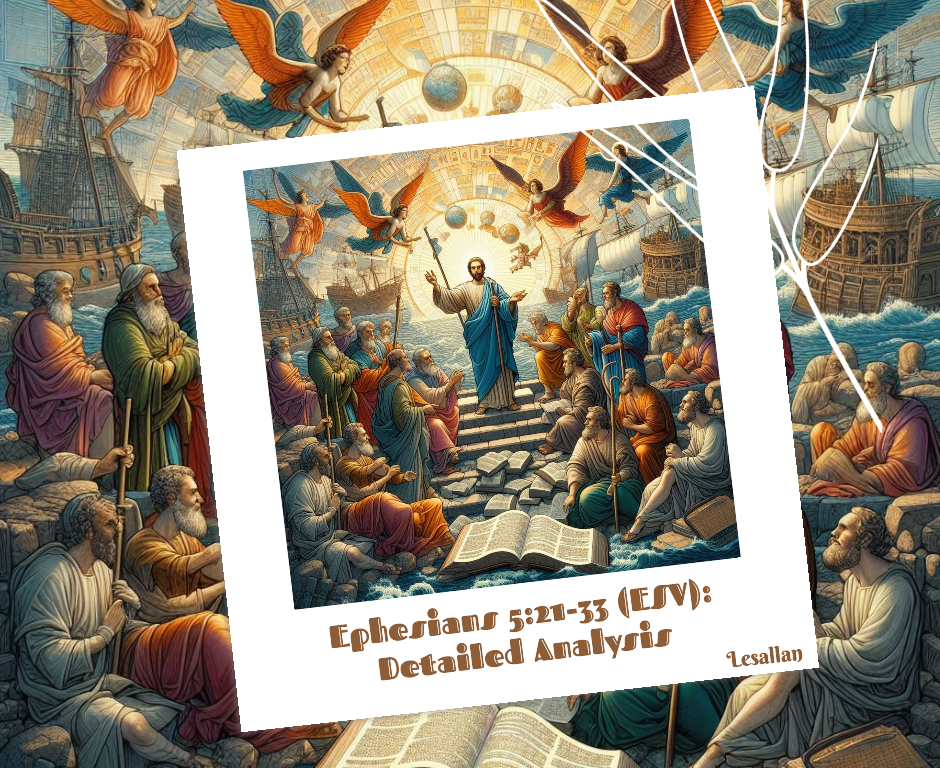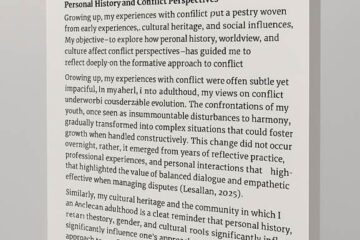Lesallan – May 10, 2024

Ephesians 5:21-33 (ESV): Detailed Analysis
Version: ESV
Initial Observations & Questions
- The passage presents an analogy between the relationship of Christ and the Church, and the relationship between husband and wife.
- How does the analogy deepen our understanding of both types of relationships?
- The passage begins with a call for mutual submission among believers, which then narrows down to the specific relationship between husbands and wives.
- How does the concept of mutual submission apply within the context of marriage?
- Were Paul’s instructions for husbands to love their wives counter-cultural and revolutionary?
Structure
The given passage furnishes explicit instructions for the married couples, while simultaneously drawing analogies between the relationship of Christ with the Church and the Christian way of living and establishing relationships.
In the fifth chapter of his writing, Paul initiates a universal call for submission to be observed by all believers (5:21). He then proceeds to apply this fundamental principle to the context of the relationship between husbands and wives (5:22-33). It is noteworthy that the guidelines for both wives and husbands are not isolated, but rather closely intertwined, indicating the crucial role of mutual submission and love in a Christian marriage.
I. Instructions for Wives (5:22-24)
A. Call to Submission (5:22)
B. Reason for Submission – As to the Lord (5:23)
C. Comparison with Christ and the Church (5:24)
II. Instructions for Husbands (5:25-30)
A. Call to Love (5:25)
B. The Model of Christ’s Love (5:26-27)
C. The Unity of Husband and Wife (5:28-30)
III. Quotation from Genesis and its Interpretation (5:31-32)
A. Quotation from Genesis (5:31)
B. Paul’s Interpretation – The Mystery of Christ and the Church (5:32)
IV. Summary and Conclusion (5:33)
A. Final Instructions for Husbands and Wives (5:33)
Words & Phrases
“submit” (5:21)
What does “submit” mean in this context?
The term “submit,” as used in this passage, is derived from the Greek word “hypotassō,” which connotes the act of arranging under or subordinating oneself. In the present context, it conveys a sense of voluntary yielding in a spirit of love and mutual respect. Such an interpretation is consistent with the broader biblical teaching on submission, which emphasizes the importance of humility, deference, and mutual submission in human relationships.
“love” (5:25)
What kind of love is referred to here?
The term used for “love” in the verse is derived from the Greek word “agapao”. This word signifies a form of love that is characterized by selflessness and sacrifice, rather than being driven by personal gain or desire. Such a noble and altruistic form of love is often regarded as a cornerstone of many ethical and moral teachings, and is highly valued in various academic and philosophical discourses.
Quotation of Genesis 2:24 (5:31)
How is Paul interpreting this Old Testament passage?
Paul employs this particular quotation to expound upon the deep connection that exists between Christ and the Church, as well as between a married couple.
“mystery” (5:32)
What does “mystery” mean in this context?
Within the context presented, the term “mystery” alludes to a veracity that was once concealed but has now been brought to light; it pertains to the profound actuality of the amalgamation between Christ and the Church.
SUMMARY, CORRELATION, & APPLICATION
The passage emphasizes mutual submission, sacrificial love, and respect.
The passage in Ephesians 5:21-33 provides guidance to husbands and wives on how to relate to each other, drawing parallels to Christ’s relationship with the Church. These principles can be applied to all types of relationships, including those in our workplaces, schools, and communities. The call for mutual submission, for example, can serve as a helpful guide for how we interact with others.
This particular excerpt exhibits a conspicuous correlation with other New Testament teachings on love and mutual submission, such as the ones found in 1 Corinthians 13 and Philippians 2:1-11. Furthermore, it draws connections to the Old Testament teachings on marriage, as described in Genesis 2:24.
This excerpt emphasizes the importance of mutual respect and sacrificial love in marriage, drawing parallels to the relationship between Christ and the Church. It urges us to reflect on how we can actively incorporate these values into our own relationships, particularly within the context of marriage. Additionally, this passage plays a significant role in the overarching theme of unity within the body of Christ, as discussed in the book of Ephesians. As with the diverse yet unified nature of a marital bond, so too does the body of Christ embody both unity and diversity.
Further questions
- How can the principles outlined in this passage be applied in marriages today, especially considering contemporary discussions around gender roles and equality?
- How does this passage inform our understanding of Christ’s love for the Church?
- How might this passage speak to those who are single or not in a traditional marriage relationship?
- Can this passage guide all of our relationships, whether we are single, married, divorced, or widowed?


